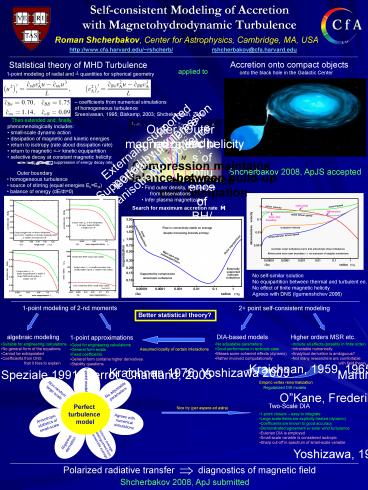Selfconsistent Modeling of Accretion with Magnetohydrodynamic Turbulence - PowerPoint PPT Presentation
1 / 1
Title:
Selfconsistent Modeling of Accretion with Magnetohydrodynamic Turbulence
Description:
Self-consistent Modeling of Accretion. with ... dissipation of magnetic and kinetic energies. return to isotropy (rate about dissipation rate) ... – PowerPoint PPT presentation
Number of Views:103
Avg rating:3.0/5.0
Title: Selfconsistent Modeling of Accretion with Magnetohydrodynamic Turbulence
1
Self-consistent Modeling of
Accretion with Magnetohydrodynamic
Turbulence
Roman Shcherbakov, Center for Astrophysics,
Cambridge, MA, USA
http//www.cfa.harvard.edu/rshcherb/
rshcherbakov_at_cfa.harvard.edu
Statistical theory of MHD Turbulence
applied to
1-point modeling of radial and - quantities for
spherical geometry
coefficients from numerical simulations of
homogeneous turbulence Sreenivasan, 1995
Biskamp, 2003 Shchekochihin, 2004
- Then extended and, finally,
- phenomenologically includes
- small-scale dynamo action
- dissipation of magnetic and kinetic energies
- return to isotropy (rate about dissipation rate)
- return to magnetic lt-gt kinetic equipartition
- selective decay at constant magnetic helicity
-
suppression of energy decay rate
Shcherbakov 2008, ApJS accepted
- Outer boundary
- homogeneous turbulence
- source of stirring (equal energies EkEM)
- balance of energy (dE/dt0)
- Find outer density, temperature
- from observations
- Infer plasma magnetization
No self-similar solution No equipartition between
thermal and turbulent en. No effect of finite
magnetic helicity Agrees with DNS (Igumenshchev
2006)
1-point modeling of 2-nd moments
2 point self-consistent modeling
Better statistical theory?
algebraic modeling
- Suitable for engineering calculations
- No general form of the equations
- Cannot be extrapolated
- Coefficients from DNS
- that it tries to explain
Kraichnan, 1959, 1965 etc.
Kraichnan 1976 Yoshizawa 2003
Speziale 1991 Perrot, Chartland, 2005
Martin, Siggia, Rose 1973
1-point model
Non-random large scale
No adjustable parameters
Two-Scale DIA
Nice try (per aspera ad astra)
- 1-point closure easy to integrate
- Large scale fields are explicitly treated
(dynamo) - Coefficients are known to good accuracy
- Demonstrated agreement w/ solar wind turbulence
- Eulerian DIA is employed
- Small-scale variable is considered isotropic
- Sharp cut-off in spectrum of small-scale variable
Agrees with numerical simulations
Anisotropic statistics of small-scale
Volume average distinguished from ensemble
average
Rigorous derivation
Yoshizawa, 1984, 2003 Yokoi et al. 2006, 2007
Polarized radiative transfer diagnostics
of magnetic field
Shcherbakov 2008, ApJ submitted






























